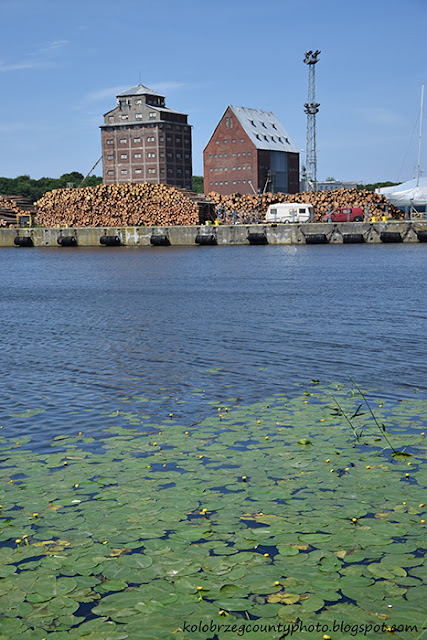Port Grain Elevators
"The port of Kolobrzeg was built in 13th century. The waterway was the most common form of transport of bulk products until the 19th century. Until the late 19th century, the Kolobrzeg port was mainly used for unloading and storing grainsin flat (floor) granaries. In 1929 The Central Economic Society of Pomerania in Szczecin constructed on this waterfront - termed grain waterfront - two modern elevators with a floor granary elevator located between them to form a line of buildings. All three elevators were connected together by the Redler chain conveyor that ran through their cellars. The southern elevator has capacity of approx. 1,700 tons and is equipped with 11 silos for grain. The northern elevator has a capacity of 4,560 tons and is equipped with 11 chambers, 9 silos, 3 gas chambers (used for pest control in crops). Original equipment has been preserved inside two elevators. Preserved items include things such as bucket conveyer and the Redler's conveyor, fanners, splitters, fans, and a type of Chronos self-acting scales - a 900 kg scale from 1929 made by MIAG,MUHLENBAU v. INDUSTRIE A.G. Company (from the north elevator)|, a 200 kg scale from about 1930 and a 500 kg scale (from the southern elevator). Elevators were registered as monuments in 2004. Currently they are located within the Commercial Port, administered by the Board of Kolobrzeg Port Ltd., and are not made available for public." Information table.
----------
"Port w Kołobrzegu powstał w XIII w. Droga wodna była do XIX w. najbardziej rozpowszechnioną formą transportu produktów masowych. W kołobrzeskim porcie przeładowywano glównie zboże, które do końca XIX w. magazynowano w spichlerzach płaskich (podłogowych). W 1929 r. Centralne Towarzystwo Gospodarcze Pomorza z siedzibą w Szczecinie wybudowało na nabrzeżu zbożowym dwa nowoczesne elewatory w linii zabudowy znajdującego się między nimi spichlerza podłogowego. Wszystkie trzy elewatory połączone były przenośnikiem łąńcuchowym Redlera, który przebiegał przez ich piwnice. Elewator południowy ma pojemność ok. 1700 ton i jest wyposażony w 11 zasieków lejowych. Elewator północny ma pojemność 4560 ton i jest wyposażony w 11 komór, 9 zasieków lejowych i 3 komory gazowe (wykorzystywane do niszczenia szkodników w zbożu). Wewnątrz obu elewatorów zachowało się oryginalne wyposażenie takie jak: przenośniki kubełkowe i Redlera, wialnie, rozdzielacze, wentylatory oraz wagi samoczynne typu Chronos: 900 kg z 1929 r. firmy MIAG.MUHLENBAU v. INDUSTRIE A.G. (elewator północny), 200 kg z ok. 1930 r. oraz 500 kg (elewator południowy). Elewatory zostały wpisane do rejestru zabytków w 2004 r. Obecnie znajdują się na terenie Portu Handlowego, administrowanego przez Zarząd Portu Morskiego Kołobrzeg Sp. z o.o. i nie są udostępniane do zwiedzania." Tablica informacyjna.
Linked to:




 "
border-radius: 100%;
border-image-source: initial;
border-image-slice: initial;
border-image-width: initial;
border-image-outset: initial;
border-image-repeat: initial;
border-width: 1px;
border-style: solid;
border-color: rgb(235, 235, 235);
margin:0;
padding: 5px;
/" />
"
border-radius: 100%;
border-image-source: initial;
border-image-slice: initial;
border-image-width: initial;
border-image-outset: initial;
border-image-repeat: initial;
border-width: 1px;
border-style: solid;
border-color: rgb(235, 235, 235);
margin:0;
padding: 5px;
/" />








...last weekend I was in Buffalo, NY which has a number of silos. These are indeed treasures from the past. Thanks so much for sharing, enjoy your day.
ReplyDeleteA bit different from the grain elevators we see here, especially in the Prairies.
ReplyDeleteInteresting photos. Please drop by and share!
ReplyDeletehttp://image-in-ing.blogspot.com/2017/07/splish-splash.html
Fascinating looking buildings.
ReplyDeleteI so love these and would love to see them for myself. I have not seen anything quite like it before...
ReplyDeleteThose are great looking buildings. For some reason, I would never have guessed they were grain elevators. I guess I'm just used to round ones.
ReplyDelete